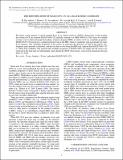| dc.contributor.author | Kalamkar, M. | |
| dc.contributor.author | Altamirano, D. | |
| dc.contributor.author | van der Klis, M. | |
| dc.contributor.author | Casella, P. | |
| dc.contributor.author | Homan, Jeroen | |
| dc.contributor.author | Linares Alegret, Manuel | |
| dc.date.accessioned | 2015-02-27T15:48:05Z | |
| dc.date.available | 2015-02-27T15:48:05Z | |
| dc.date.issued | 2011-03 | |
| dc.date.submitted | 2010-12 | |
| dc.identifier.issn | 2041-8205 | |
| dc.identifier.issn | 2041-8213 | |
| dc.identifier.uri | http://hdl.handle.net/1721.1/95724 | |
| dc.description.abstract | We report on the analysis of all 65 pointed Rossi X-ray Timing Explorer (RXTE) observations of the recently discovered soft X-ray transient MAXI J1659-152 (initially referred to as GRB 100925A). The source was studied in terms of its evolution through the hardness-intensity diagram (HID), as well as its X-ray variability properties. MAXI J1659-152 traced out a counterclockwise loop in the HID, which is commonly seen in transient low-mass X-ray binaries. The variability properties of the source, in particular the detection of type-B and type-C low-frequency quasi-periodic oscillations, and the way they evolve along the HID track, indicate that MAXI J1659-152 is a black hole candidate. The spectral and variability properties of MAXI J1659-152 imply that the source was observed in the hard and soft intermediate states during the RXTE observations, with several transitions between these two states. | en_US |
| dc.description.sponsorship | NWO of the Netherlands (Rubicon Fellowship) | en_US |
| dc.language.iso | en_US | |
| dc.publisher | IOP Publishing | en_US |
| dc.relation.isversionof | http://dx.doi.org/10.1088/2041-8205/731/1/L2 | en_US |
| dc.rights | Article is made available in accordance with the publisher's policy and may be subject to US copyright law. Please refer to the publisher's site for terms of use. | en_US |
| dc.source | American Astronomical Society | en_US |
| dc.title | THE IDENTIFICATION OF MAXI J1659-152 AS A BLACK HOLE CANDIDATE | en_US |
| dc.type | Article | en_US |
| dc.identifier.citation | Kalamkar, M., J. Homan, D. Altamirano, M. van der Klis, P. Casella, and M. Linares. “THE IDENTIFICATION OF MAXI J1659-152 AS A BLACK HOLE CANDIDATE.” The Astrophysical Journal 731, no. 1 (March 15, 2011): L2. © 2011 The American Astronomical Society | en_US |
| dc.contributor.department | MIT Kavli Institute for Astrophysics and Space Research | en_US |
| dc.contributor.mitauthor | Homan, Jeroen | en_US |
| dc.contributor.mitauthor | Linares Alegret, Manuel | en_US |
| dc.relation.journal | The Astrophysical Journal. Letters | en_US |
| dc.eprint.version | Final published version | en_US |
| dc.type.uri | http://purl.org/eprint/type/JournalArticle | en_US |
| eprint.status | http://purl.org/eprint/status/PeerReviewed | en_US |
| dspace.orderedauthors | Kalamkar, M.; Homan, J.; Altamirano, D.; van der Klis, M.; Casella, P.; Linares, M. | en_US |
| mit.license | PUBLISHER_POLICY | en_US |
| mit.metadata.status | Complete | |
